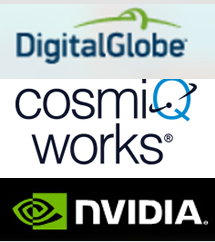
An online repository of satellite imagery and labeled training data — SpaceNet — has now launched and will benefit machine learning and deep learning algorithm advancements for leveraging remote sensing data.

SpaceNet is a collaboration between DigitalGlobe, CosmiQ Works, and NVIDIA and the imagery is now freely available as a public data set on Amazon Web Services, Inc. (AWS). GPU-accelerated deep learning has led to huge breakthroughs in the field of computer vision. Most of this innovation has occurred through research enabled by ImageNet, a database of 14 million photographs labeled in over 20,000 categories. SpaceNet aims to facilitate similar advances in automating the detection and extraction of features in satellite imagery, fueled by the massive amount of information about our changing planet that DigitalGlobe collects every day, and that of emerging commercial satellite imagery providers.
Until now, high-resolution satellite imagery has not been readily accessible for data scientists and developers to build meaningful computer vision algorithms. SpaceNet will, for the first time, open access to a large corpus of curated, high-resolution satellite imagery to incubate algorithm development.
SpaceNet will launch with an initial contribution of DigitalGlobe multi-spectral satellite imagery and 200,000 curated building footprints across the city of Rio de Janeiro, Brazil. This initial contribution will provide the necessary data to create new algorithms to automate the extraction of features such as buildings in dense urban environments. Over time, the mentioned companies anticipate making more than 60 million labeled satellite images accessible to the public via SpaceNet.
According to Tony Frazier, the Senior Vice President at DigitalGlobe, SpaceNet is key to unlocking a huge explosion of new AI-driven applications that will ultimately help better the response to natural disasters, counter global security threats, improve population health outcomes, and more. The industry is coming together to power smarter algorithms in order for all to see and learn things from imagery about the planet that simply cannot be known today through manual techniques.
Dr. Jon Barker, the Solutions Architect at NVIDIA, added that researchers will be able to create high-impact geospatial applications by applying DIGITS deep learning tool to the SpaceNet data corpus.
To access the data, visit SpaceNet on AWS at aws.amazon.com/public-data-sets/spacenet/

